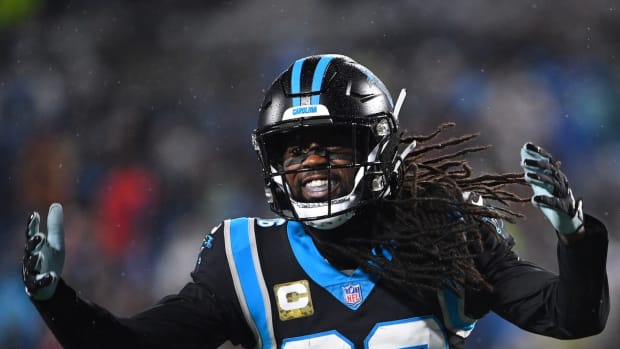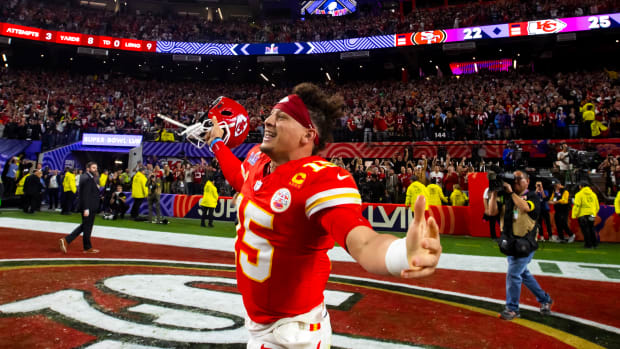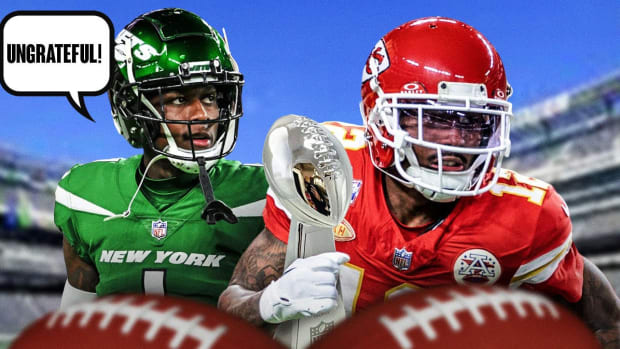Bill Belichick and Special Teams: A Love Story
On Nov. 4, 2014, Bill Belichick’s Patriots were entering their bye week at 7-2 following a 22-point victory over Peyton Manning’s Broncos. Belichick was in good spirits, and one reporter seized the opportunity:
“I have a historical question for you, and while you were in grade school during this period I’m hoping that you have some insight based on your study of the game. What was it like for Gino Cappelletti kicking field goals back in the ’60s?”
Belichick: “Well, yeah, I mean I was—thank you for not dating me back quite that far. When I first came into the league in 1975, I think we talked about this before, I would say most teams had a kicker. Some teams had a punter, other teams had a guy that played a position and also punted. Then most every team had a position player who was the long snapper, either an offensive lineman or a linebacker or tight end or somebody like that. There were very, just pure long snappers like every team has now. There were, as I said, some punters, probably there were more punters than there were position players punting . . . ”
By the time it was over Belichick had delivered a 1,039-word response, one of his longest press conferences answers on record. He touched on the specialization of long snappers, on how much more the kicking unit practices together now compared to then, the inconsistency of the turf from then to today and somehow ended with a discussion on how punt formations began spreading out in the mid-80s. (If you’re interested, the full exchange can be read here.)
One of the greatest head coaches in sports history, Belichick served as an assistant special teams coach in Detroit and Denver in the 1970s before taking the special teams coordinator role with the Giants from 1979-84. His affinity for special teams play is obvious in his press conferences. Want to know about injuries, or break down a specific offensive call that broke the game wide open? Ha! Good luck. But if you’re wondering about the history of left-footed punters, better make sure you brought extra batteries for your recorder.
Motivated by Belichick’s effusive praise of New Orleans Saints punter Thomas Morstead last month (“great leg strength, placement, technique . . . he’s really good, really good”), I set out to document a brief history of Belichick’s love of special teams play. I enlisted good friend/stats wizard/coding savant Kevin Hogan to run a script of the archived Patriots transcripts, going back to 2007, that looked for any Belichick reference to “kick,” “punt” or “special teams.” There were 3,657 such instances.
The spreadsheet Kevin created is essentially a clinic on special teams play—a free resource to any aspiring special teams coach. Below are some of Belchick’s best quotes on his favorite subject . . .
METEOROLOGY-BASED STRATEGIES
Oct. 28, 2013
“The wind conditions are always a factor in the kicking game first and then in the passing game. I’d say one of the biggest decisions and most critical decisions that I’ve ever been a part of on that was in the 1986 NFC championship game against the Redskins. It was a windy day in Giants Stadium. We’ve had many of those and we won the toss and Coach [Bill] Parcells elected to take the wind, which wasn’t very common. It wasn’t a very common decision because, let’s face it, you take it in the first quarter you’re not going to have it in the second quarter. That was what he decided to do and we were able to really take advantage of that situation against the Redskins. We got three stops and 17 points and we had a 17-0 lead at the end of the first quarter in part due to the wind, good defense and good offense helped of course. But the field position was huge and that ended up being the final score of the game. That decision, the initial points and the way that the game started really was a huge part of what was reflected in a huge degree to that decision that Bill made. That was a good lesson for me to learn in my career. It was a great decision by Coach Parcells.”
Jan. 17, 2008
“There’s light rain and then there’s a hurricane. There’s wind and then there’s . . . a lot of wind. If you’re talking about a lot of anything—a lot of snow, a lot of rain, a lot of wind—that affects it a lot more than a little bit. Certainly the wind affects the kicking game, number one. Of course, the dampness, whether it’s rain or snow, affects footing and ball-handling probably more than wind does, obviously. So, if you’re talking about kicking into a wind, that’s probably a lot worse than punting in snow, but if you’re talking about handling the ball, that would be a lot worse in rain than it would in wind. It just depends what aspect of the game you’re talking about.”
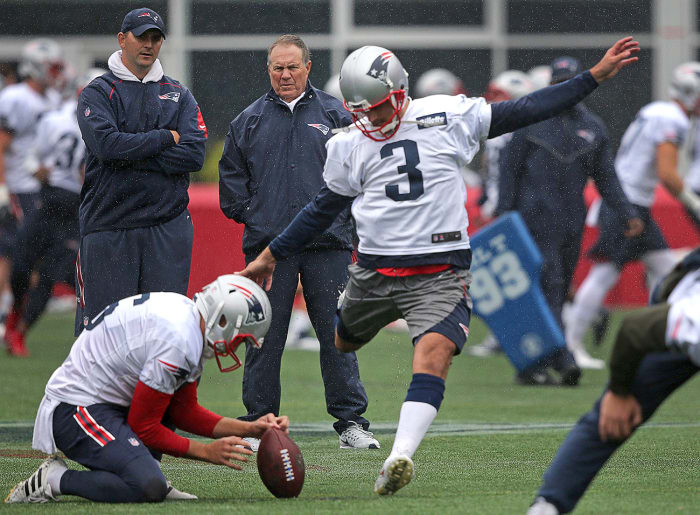
Stephen Gostkowski kicking off newly installed Gillette Stadium turf in September held Belichick's attention.
Barry Chin/The Boston Globe/Getty Images
THE LEGEND OF THE LEFT-FOOTED PUNTER
Nov. 4, 2014
“That’s a good question. There’s definitely something—a left-footed punter, right-footed punter, the ball spins opposite and what you get used to when you go to the other foot it’s reversed. I think there’s definitely something to be said for that, practicing that way. I know going back to when we were at the Giants and I was the special teams coach there, we had a right-footed punter obviously with [Dave] Jennings and then with [Sean] Landeta and when we would face a left-footed punter, we always kind of just wanted to get the returner to handle those balls, which was [Phil] McConkey. I definitely remember McConkey talk about how that would [spin], even though he’d done it before, it was just good to get familiar with it prior to doing it in the upcoming game. [Phil] Simms would punt to him. Even though Phil [Simms] does a lot of things right-handed, he punts left-footed, believe it or not, and actually punts pretty well. So, we would do that.
“I had a lot of right-footed punters. I had Jennings, I had Tom Tupa in Cleveland, [Brian] Hansen and then when I came here, we had a left-footed punter with [Lee] Johnson and then it just was [Ken] Walter and [Josh] Miller and it’s just kind of evolved that way. Now we had [Todd] Sauerbrun for a while, half a season or a third of a season, whatever it was, but for the most part it’s been left-footed punters since I’ve been here in New England. That’s not really by design. I’d say it’s just more kind of worked out that way. But it is kind of a long coincidence of that. But it was probably just as much a coincidence that it was the other way.”
EVERYTHING YOU NEVER THOUGHT TO THINK ABOUT PUNTING
Dec. 26, 2012
“I think punting is a little bit like golf. It’s not just standing out there on the driving range and hitting drives. A lot of it is situational punting: punting relative to the rush, punting relative to the team’s return tendencies or to where to give your gunners better opportunity to make the play, backed up, plus-50, end of the game situations or end of the half type situations, with wind and field conditions and all that. Probably less than half the punts, for most teams, the punter can just punt it high and long—just stand out there on the driving range and bang it away. There’s another high percentage of plays, I would say over 50% that involve some type of situational punting, a different type of punt. It’s not just your long, high one, it’s something else.
“To be a good punter, you have to be good at all those things. You can’t just be a long driver, you have to be able to place the ball, to speed up your operation in rush situations, be able to directional it and handle all the different conditions and situations. Most punters in the league are holders as well, not all but most. That’s certainly an important part of that position too, is the holder on placements. It’s really a position that I think there’s a lot more variety to what they have to do than what people think, certainly more than a kicker. When you kick off, for the most part you’re just trying to get it high and deep or if you’re a directional team, then O.K., you just have one direction to kick it deep in. Field goals are field goals, you have to kick the ball straight. The punting game, I think there are a lot more variables to it that affect the punter and specialists. Of course, handling the snap is another part of it as well. It’s not like baseball where you can just take the ball on the mound and grip it however you want to grip it and throw it. You have to kick it but you have to handle it and you have to deal with the guys that are coming after it trying to block it.”
Nov. 27, 2013
“There’s nothing more important—this might sound stupid but there’s nothing more important for a punter than hands because without good hands, handling the ball and being able to place and drop the ball properly on your foot, no matter how strong your leg is, you’re not going to be able to punt consistently. You can’t really be a good punter, not a really good punter, if you don’t have good hands. So, the Dave Jennings and the Tom Tupas and guys like that I’ve coached that were, even [Sean] Landeta, those guys had really good hands, not only catching the ball and handling the snaps but being able to place the ball properly on their foot so that they could have the contact that they needed to punt it. I don’t think, when you’re evaluating a punter, one thing you don’t want really is a punter that doesn’t have good hands. It’s just hard to punt the ball consistently—no matter how strong the guy's leg is—if he’s not a smooth ball handler.”
From Staubach to Dak: An Oral History of the Cowboys’ Quarterbacks
ACKNOWLEDGING GREATNESS WHEN HE SEES IT
Dec. 9, 2015
“[Shane] Lechler is obviously one of the great punters of all time, so they're very good in that area.”
Nov. 30, 2016
“[The Rams] have a lot of very good players, a lot of explosive players in all three phases of the game. Let’s start with the kicking game; I mean [Johnny] Hekker is a tremendous weapon. This guy looks like as good a player as I’ve ever seen at that position. He’s a tremendous weapon in his ability to punt the ball, punt it inside the 20, directional kick it, involved in fakes, can throw, can run, very athletic.”
Sept. 13, 2017
“I mean, [Thomas Morstead] has got great leg strength, placement, technique. He’s a good situational punter, handles the rush well, good directional punter, good plus-50 punter, can change field position. I mean, he’s really good, really good.”
Dec. 13, 2013
“I think, it’s maybe a little bit like [Tom] Brady. [Stephen Gostkowski] gets a little bit better each year, but he started off at a pretty high level. He’s had a lot of great years for us and individual plays. He continues to work hard at his job, his training, his conditioning, his technique, obviously the execution with his other teammates on field goals. He just becomes a better student of the game, more knowledgeable, more experienced, better situational player. But it’s incremental. It wasn’t like it started at a low point. It started at a pretty high point and it’s gradually ratcheted it up a little bit. You talk about Brady, where he was in ’02, ’03, ’04, he played at a pretty good level but has continued to improve since then too. His work ethic and attention to detail and focus on a lot of little things, but again, it wasn’t the jump that he made his first year, let’s put it that way.
Nov. 11, 2014
“Yeah, [Adam Vinatieri] is really kicking the ball great. The ball goes perfectly straight. It doesn’t move. It just [goes]. Every kick is right on the money. You have to try to block it. Waiting for him to miss, you'll be waiting all day. You have to see if you can somehow affect the kick. Yeah, he's kicked the ball great, no question.”
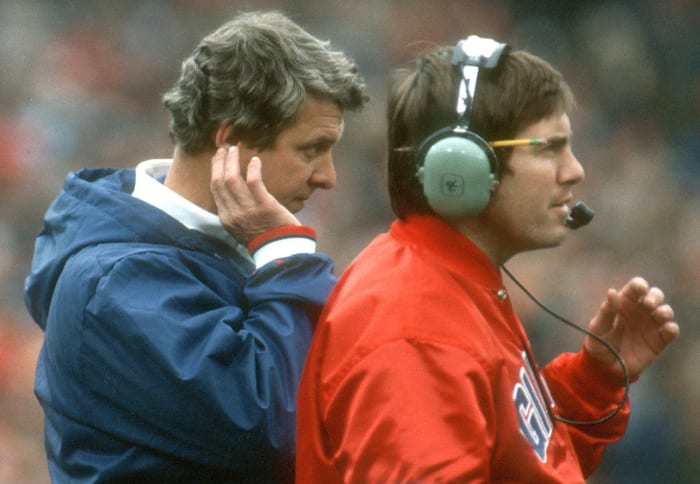
Before he was defensive coordinator for the Giants, Belichick served as linebackers and special teams coach for Bill Parcells in the early 1980s.
Arthur Anderson/Getty Images
WHEN YOU’RE ON THE RECEIVING END
Oct. 27, 2008
“I think when you punt from inside the 5 with the punter a little bit closer, a lot of time, psychologically, the protection is thinking, I have to stay in longer, we don’t have as much room to punt, it is not our normal punting depth from the center to the punter. And also when you make a team re-kick it, guys aren’t as fresh and you don’t get quite the same energy in the coverage sometimes on that second time around.”
Dec. 16, 2011
“Every kick is different; each ball is a little bit different. But the concept in terms of recovering them, blocking the guys who are the most dangerous guys to get the ball so that your player can come up and recover it is, that’s what you’re trying to do. Where that ball is, where it comes down exactly, what the angles are and how quickly your guy can get to it and who is the most dangerous of the guys they have other there and now with the rules being what they are, you can’t really overload, you can only overload with six guys so a lot of times you see the five and five look and teams can kick it either way. It’s just another thing to prepare for, another thing you have to work on.”
DEFENDING THE THREE-POINTER
Nov. 21, 2014
“I’m just saying you had more options. Back in the ’70s, you had the jumpers, you had the Matt Blairs and the guys like that that would have five, six, seven blocks a year. That was eliminated. Now you can’t hit the center so the center is probably the weakest by far protector on any team’s field goal unit, but you’re not allowed to hit him. You can’t line up on him so that’s another opportunity you don’t have. You can’t overload so you can only put six guys to a side, so that’s another—you don’t have that extra guy to create that extra gap so you can’t do that. You can’t push anybody from behind.
“Is it easier? I’d say it’s a lot harder because you have a lot less options. And on top of that, the kickers are better. The surfaces are much, much better. You don’t have some of the bad fields where it was hard just to kick the ball period—the baseball stadiums and the infield that got sodded and all that. You’re not dealing with those kind of situations. Kicking off the dirt, you don’t see that anymore. The kickers have gotten better and the conditions have gotten much better and you’re kind of not allowed to do a lot of things that you would normally do to try to block a kick. So, yeah, it’s gotten harder.”
Chris Mortensen’s Cancer Battle
WHEN IT COMES TO SPECIAL TEAMS CALLS, EVEN THE GREAT ONES CAN BE HUMBLED
Dec. 4, 2009
“Well, one of the worst [gadget] ones I’d say that I ever ran was in ’79 against the Rams, when I was the special teams coach on the Giants. We had run five or six fake punts that year, and hit all of them and so we went out to play L.A. in the Coliseum and we didn't have a real good team. [Dave] Jennings was our best . . . It was [Phil] Simms’ rookie year and Jennings was one of our best players, All-Pro punter. I mean, he was great, and he could throw. He was a very athletic guy, so we had several fake punts that we hit. And unfortunately we were punting a lot, so that gave us more opportunities than we needed. We went out to the Rams and Brian Kelley was a fullback, so we snapped the ball to Kelley and he ran a sweep. And kind of once he was about to get tackled, he stopped, turned, and lateraled it back to Jennings on the other side of the field.
“It wasn’t very well executed and then when Jennings caught the ball, he thought he had a chance to get the first down, but he really didn’t. But he thought he did, so he ran for the sticks there on the sideline and then about three guys hit him about four yards short of the first down, knocked him out of bounds. I mean, he got knocked over by the cheerleaders. His helmet was on sideways, he’s looking out through the ear hole. The ball is out there on the track somewhere and [Head Coach Ray] Perkins looks over at me with that look of, What are we doing? This is our best player. And he looked like he got run over by two Mack trucks. So we go all the way over to the other side of the field and get him off the track and put him back together again. He got killed and then Ray said—which I would have done the same thing [but] I wouldn’t have done it as nicely as he did—he said, “Look, we’re not running any more fakes like that again. Just forget that.” He didn’t quite put it that way, but you get the idea. So that was one that didn’t work that luckily Dave and I can still smile about.
“I mean, to be honest with you, it wasn’t a lot different—the play was different—but the result wasn’t a lot different than what we ran with Brian Moorman on the fake in the Pro Bowl [Belichick coached the AFC team in the 2007 Pro Bowl]. Sean Taylor hit him and I mean, that was . . . I mean, Brian could have taken less of a hit on that. Jennings caught the ball coming from the other side of the field and didn’t really have [much of a chance.] ... Brian was running. At least he had a little chance to, but Sean Taylor hit him. That was a massive hit. It was right in front of our bench. I thought it was . . . Oh, my God.”
THE STRATEGY OR PRACTICING STRATEGY
Nov. 5, 2009
“I think that each week 85% of our time on special teams is pretty constant. There is maybe another 15% that would change week to week, depending on where we feel like we want that emphasis, whether it’s on punt protection or kickoff coverage or kickoff returns or fakes—whatever the point of emphasis for that particular team happens to be. So I would say 85% of it is going to be, but we go into the game and say we think we can block a punt this week, so we spend a little more time on our punt rushes or we’re worried about their field goal rush, so we spend a little more time on our field goal protection or we’re worried about their fakes then we spend a little more time on showing those extra fakes or whatever it happens to be.”
HOW, DEEP DOWN, EVERYONE MUST BE A SPECIAL TEAMER
Oct. 23, 2015
“You don’t go into the game thinking about losing two guys at the same position. When that happens, that’s a difficult situation. And particularly in the kicking game because now you’re talking about that’s 66 players on special teams—kickoff, kickoff return, punt, punt return, field goal, field goal rush—that’s 66 players. That means you have to have 66 backups. I mean, you’ve got to have it. So, this guy is out on this team, who is going in for him? You’ve got to have somebody. It might be the same guy for five positions, but you’ve got to have somebody. O.K., now you lose two guys at the same spot, again two anything—two safeties, two corners, two linebackers, two whatever they are—and they’re going to be playing the same players in the kicking game.
“I can tell you from experience having been a special teams coach, you’re really talking about making some adjustments. Like I said, it’s hard enough to lose one because you’re looking at 66 plus 66. You start dropping down below that, then the opportunity to even give that guy reps at that position when you get 11 guys on the field, whoever that guy is, just getting him out there is one thing, him having reps at what he’s doing is probably that would be a dream I would think that most likely didn’t happen during the week. So, those are tough. Lose two long snappers, lose two punters, lose two anything—that’s pretty challenging.
“But special teams, people don’t realize how difficult it is to just manage the roster in the kicking game because there are a lot of guys you can just eliminate from special teams. You don’t seen any offensive linemen on the kickoff team, you don’t see any defensive linemen on the kickoff team, you don’t see any quarterbacks, other than the kicker and the punter, so you can take probably 15 to 20 players and just eliminate them from a lot of those teams. So now you’re working with a much shorter list. And what that total number is, is one thing, but realistically what that number is, is it’s another ball game. So you start talking about how many players you actually have and then you’re looking at 66 spots minus the field goal team, you start looking at 66 spots and then who backs those 66 spots up and then who’s behind them.”
CHOOSING YOUR HOLDER WISELY
Aug. 26, 2009
“A lot of teams used to use backup quarterbacks [as holders]. Even in some cases, wide receivers as holders. Same thing, you have a punter, a snapper and a kicker that can spend an hour a day working on that timing and that skill and you have a quarterback who at the end of practice comes over and holds 10-15 kicks. If you’ve got a punter that can do it, you probably have a better operation with him doing it along with the fact that a quarterback’s out for a series with a sprained ankle, so who’s your next holder? So you come down to the play of the game and you don’t know who your holder’s going to be on a key play like that. If you can afford it, I think you do it.”
JOURNALISTIC GUIDANCE
Nov. 7, 2008
“The more [I] watch [the Bills] in the kicking game the more appreciation that I have for what they do on a week in and week out basis. [This is] something that doesn’t get a lot of attention if someone is looking to fill up some space, I don’t know.
• Question or comment? Email us at talkback@themmqb.com.



































